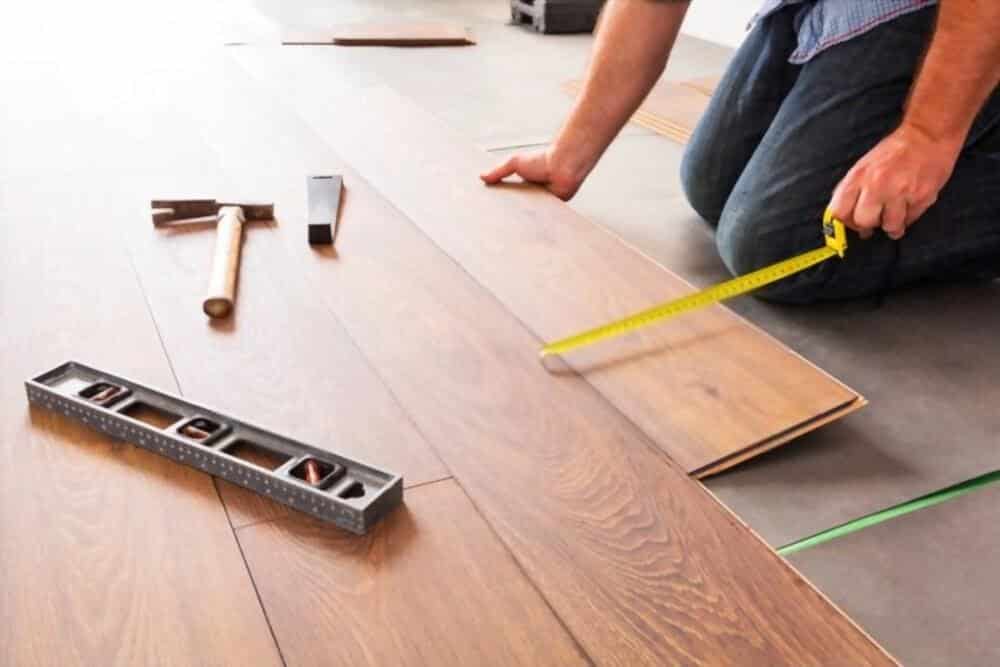There are a few specific steps and a list of dos and don’ts to follow during laminate flooring.
A process that needs a lot of precision, accurate measurement, and cutting, laying the material and more. It is for this reason you should call a professional for that matter always.
First, you will need to prepare the room. If it is small, you should remove all the furniture.
If it is large then you can shove everything on one side, complete laying half of the floor and then move the furniture there and continue with the rest of the room.
Next, you must inspect the room to find whether there is any quarter-round shoe molding near the base of the baseboard molding.
If there is any, make sure that you remove it but be careful enough so that the baseboard molding stays in place.
You can use a thin pry bar or a hive tool to pry the shoe molding up without damaging the rest of it.
Trimming the doorways is also necessary to ensure that the planks used for laminate flooring fits in properly around the doorways.
You must trim the side jambs and door casing so that the planks slip underneath.
Focus On The Subfloor
The next important step of laminate flooring is to work on the subfloor. You must make sure that it is as smooth and clean as possible.
This will ensure proper functionality of the laminated flooring. Inspect the subfloor thoroughly, even if you must crawl around looking for uneven areas.
Even a 1/8-inch unevenness should be taken into consideration.
If the peaks are not major, then you can use a belt sander with a coarse grit to smoothen it up.
However, if the peaks are severe, you will need to hire a commercial floor sander to grind them down.
Smoothening the peaks in the subfloor is especially important aspect of prepping the surface for laminate flooring and should not be ignored at all.
As unevenness will create a dip in the floor, and in turn, it will create a soft and spongy section on the laminate floor and increase the chances of developing cracks easily.
Therefore, take care of these dips using a trowel and a vinyl floor patch.
If you are in a hurry and want to laminate the floor on the same day of patching it, then make sure that you buy the fast-drying variety of the vinyl floor patch.
Dos And Don’ts List
When you proceed with the laminate flooring process, you should keep these specific things in mind:
- Read and follow the instructions of the flooring manufacturer
- Determine the direction and pattern of flooring before start
- Allow at least 48 hours to adjust the floor to room temperature before installing
- Have all the tools and materials ready
- Use proper laminate material
- Tape the seams of the underlayment together
- Inspect the planks for any visible damage
- Leave expansion gaps around the perimeter of at least .25″ for smaller and 5″ for larger areas
- Stagger rows at one plank width from the other and
- Use joints 12” to 18″ apart for basic support.
The list of don’ts, though not if the do’s list, are also equally important to know and follow during laminate flooring. Ideally, you should not laminate a floor if:
- It has a drain
- It has an uneven subfloor
- It is exposed to extremely low or high humid conditions and constant dampness and
- It is in an outdoor setting.
Finally, you should not laminate over residential carpet, double layer of underlayment, lengthwise without a transition strip if it is over 30 linear feet.
- How Primary Care Doctors Are Your First Line of Defense - December 23, 2024
- Live-In Caregiver Jobs: Providing Support, Building Bonds - December 19, 2024
- Caring for Your Porcelain Veneers: Tips for a Lasting Smile - November 12, 2024
